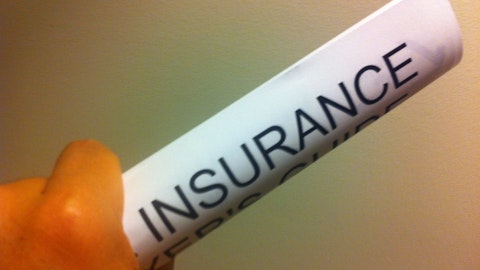Corebridge Financial, Inc. (NYSE:CRBG) Q2 2023 Earnings Call Transcript August 4, 2023
Operator: Hello, everyone, and welcome to the Corebridge Financial Second Quarter 2023 Earnings Call. My name is Emily, and I’ll be coordinating your call today. [Operator Instructions]. I will now turn the call over to Josh Smith, Investor Relations with Corebridge Financial. Josh, please go ahead.
Josh Smith: Good morning, everyone, and welcome to Corebridge Financial’s earnings update for the second quarter of 2023. Joining me on the call are Kevin Hogan, President and Chief Executive Officer; and Elias Habayeb, Chief Financial Officer. We will begin with prepared remarks by Kevin and Elias, and then we will take your questions. Today’s remarks may contain forward-looking statements, which are subject to risks and uncertainties. These statements are not guarantees of future performance or events and are based upon management’s current expectations. Corebridge’s filings with the SEC provide details on important factors that may cause actual results or events to differ materially. Except as required by the applicable securities laws, Corebridge is under no obligation to update any forward-looking statements if circumstances or management’s estimates or opinions should change.

photo by scott graham on Unsplash
Additionally, today’s remarks may refer to non-GAAP financial measures. The reconciliation of such measures to the most comparable GAAP figures is included in our earnings release, financial supplement and earnings presentation, all of which are available on our website at investors.corebridgefinancial.com. With that, I would now like to turn the call over to Kevin.
Kevin Hogan: Thank you, Josh, and good morning, everyone. This was another excellent quarter for Corebridge. We continue to benefit from focused execution, disciplined risk management and the competitive strengths of our diversified businesses. During the second quarter, we returned $750 million to shareholders through a combination of dividends and share repurchases, bringing the total capital return since our initial public offering to $1.2 billion. With this milestone, we are honoring our commitment to begin to return capital beyond regular quarterly dividends within 9 months of the IPO. We remain focused on our capital management strategies, and we are on track to achieve a 60% to 65% payout ratio in 2024. This morning, I will focus on our strong financial performance and provide an update on the progress we are making towards our key financial targets as well as our strategic and operational priorities.
For the second quarter, Corebridge reported operating earnings per share of $1.04 with an adjusted return on average equity of 11.7%. This reflects strong results from our core businesses as we remain well positioned to capitalize on current market opportunities. Base spread income rose 42% year-over-year, benefiting from higher new money yields as well as the cumulative effect of ongoing strong growth in our spread-based products. Across our 4 businesses, we delivered robust sales, generating approximately $10 billion of premiums and deposits, 42% higher than the prior year quarter. Second quarter conditions remained attractive for spread-based products, and we produced another quarter of robust new business, most notably in pension risk transfer and fixed index annuity.
In institutional markets, we executed $1.9 billion of pension risk transfers. Our pipeline is strong, and we have positioned ourselves well to support the growing demand for full plan terminations. We also issued over $900 million of guaranteed investment contracts. For individual retirement, we produced $2.3 billion of fixed index annuity sales, a record-setting quarter for us in this product category. Conditions remain very favorable for fixed index products, and we expect the strong customer value proposition to continue driving sales in this environment. With respect to fixed annuity, we continue to deliver strong sales, reaching nearly $1.3 billion. We balanced market opportunities with meeting the operational demands of this product in light of the volume of transactions associated with our record level first quarter.
The market remains attractive, and we will continue to respond within the context of our entire product portfolio. As the second quarter demonstrated, one of the key strengths of Corebridge is the ability to operate across product lines and respond to market dynamics while continuing to pursue profitable organic growth where risk-adjusted returns are the greatest. Thinking about the second half of the year, we expect favorable conditions for spread-based products to continue. We will remain disciplined with our capital deployment, simultaneously balancing competitiveness with margins and operational demands. Before I move away from sales, I want to take a moment to recognize the significant contributions our distribution platform has made to our organic growth.
Corebridge Financial distributors is our team of in-house professionals with strategic long-term relationships across all of our distribution partners, including banks, broker-dealers, general and independent agencies and independent marketing organizations. Corebridge Financial distributors has enabled us to build a leading distribution platform through a range of partnerships. In the second quarter, this team was responsible for delivering over $9 billion of our premiums and deposits. We believe the breadth of our product offerings and long history of partnerships strengthen our relationships and serve as the foundation for our success. Let me now shift to some other areas of strength for Corebridge. In the 9 months since our initial public offering, we have consistently focused on executing our strategic and operational priorities and achieving our financial targets.
We have begun to deliver significant return of capital to shareholders, and we are on track to meet our targeted adjusted return on equity and payout ratio in 2024. We are also well on our way towards achieving the promised run rate savings from Corebridge Forward as we have discussed on previous calls, and we are making consistent progress in our operational separation from AIG. Our actions over the last several quarters demonstrate the confidence we have in our balance sheet and the strength of our cash flows. Yesterday, we declared our fifth consecutive quarterly dividend of $0.23 per share. With this dividend, we will have returned over $1.35 billion in capital to shareholders since our IPO. This includes regular quarterly cash dividends totaling approximately $750 million, along with a special dividend in June of just over $400 million.
Also in June, we repurchased $200 million of shares from AIG and Blackstone. This leaves us with $800 million remaining from the initial $1 billion share repurchase authorization we announced in May. Shifting to return on equity. Our run rate ROE for the first half of 2023 was approximately 12%. At the time of our IPO, our run rate was about 10%. This improvement was driven in large part by strong organic growth and improving base spread income. Looking ahead, we believe we are on a firm trajectory to achieve a 12% to 14% ROE in 2024, in line with one of the key financial targets we laid out when we launched Corebridge. With regards to Corebridge Forward, our modernization program that will deliver both expense reduction and increased efficiency, we have accelerated timing wherever possible and remain ahead of plan, having achieved or contracted on 75% of our exit run rate savings goal of $400 million.
Thus far, we have largely completed the initiatives related to refining our target operating model and expanding our outsourcing with existing partners. The bulk of the remaining work is focused on modernizing our IT infrastructure and rationalizing our real estate footprint, which is expected to be complete in 2024. The last leg of our incremental cost savings will be driven by significant milestones and will not be linear. Above all, we remain confident that Corebridge Forward will be completed on time and that the majority of the run rate savings will be achieved within 24 months of our IPO. And we are on track with our operational separation from AIG. Given the progress we have made establishing our stand-alone capabilities as a publicly-traded company, the majority of our remaining work will be on the separation of shared IT applications, which we continue to believe will be mostly complete in 2023 with some work extending into 2024.
Turning to other strategic actions. You saw in our announcement yesterday that we’ve agreed to sell our health insurance business in Ireland, Laya Healthcare, to AXA for €650 million, unlocking significant value for our shareholders. We expect the transaction will close in the fourth quarter subject to regulatory approvals. As noted on AIG’s earnings call, we expect proceeds from this transaction will largely be used for a special dividend to Corebridge shareholders. Additionally, as also mentioned during AIG’s earnings call, we recently retained advisers to analyze strategic alternatives for the disposition of our U.K. Life business. The dispositions of Laya and U.K. Life will streamline our portfolio and allow us to focus on life and retirement products and solutions in the United States.
In conclusion, I am very pleased with our performance in the second quarter. Our broad product platform, diverse sources of earnings and very strong network of distribution partners stand as important strategic advantages for Corebridge and position us well to perform in different market environments. We continue to see favorable operating trends driving an increase in aggregate core sources of income. We are executing our strategic initiatives and believe the strength of our franchise and balance sheet will enable us to continue to create value for our shareholders. We are delivering on our commitment to return attractive levels of capital beyond regular quarterly dividends, and we are on pace to achieve a 60% to 65% payout ratio as well as a 12% to 14% return on equity in 2024.
Now I will turn the call over to Elias.
Elias Habayeb: Thank you, Kevin. This morning, I’ll provide key highlights on our strong financial performance in the second quarter as well as provide an update on our balance sheet and capital management activities. Corebridge continues to make great progress delivering on its goals with favorable trends supporting the growth of spread products, especially in individual retirement and institutional markets. Earlier today, we reported earnings per share of $1.04, which was up 37% year-over-year and 7% sequentially. We also reported an adjusted ROE of 11.7% for the second quarter, which puts us at a run rate of approximately 12%. Adjusted pretax operating income was $836 million, an increase of $225 million compared to the prior year quarter.
Excluding variable investment income, adjusted pretax operating income was 51% higher than the prior year quarter, largely due to higher base spread income, partially offset by interest expense on financial debt issued in the second and third quarters of 2022. Sequentially, our reported adjusted pretax operating income was $112 million higher than the first quarter due to improved base spread income and variable investment income as well as lower expenses. Our aggregate core sources of income increased by 18% year-over-year, driven by the growth of base spread income and underwriting margin, partially offset by the decline of fee income. Assets under management and administration ended the quarter at $372 billion, up 4% year-over-year or 1% sequentially.
Turning to net investment income and our investment portfolio. Net investment income for our insurance subsidiaries on an adjusted pretax operating income basis was $2.5 billion, up 24% year-over-year or 8% sequentially. Our net investment income continues to reflect strong base portfolio income, offset by variable investment income below historical averages. Base portfolio income was $2.4 billion, up 27% year-over-year or 5% sequentially. The yield on our base asset portfolio was 4.6%, up 76 basis points year-over-year and 18 basis points sequentially, driven by a combination of reinvestment activity at higher new money yields and an increase in total invested assets. Total invested assets grew approximately $10 billion year-over-year or over $1 billion sequentially on a book basis.
Average new money yields were over 6.6% in the second quarter, approximately 220 basis points higher than the average yield on assets rolling out of the portfolio. This is the fourth consecutive quarter with significant yield uplift. While we expect the favorable trend to continue based on current new money yields, the quantum of sequential improvement may slow down. Variable investment income was $96 million for the quarter, down 20% year-over-year or up 243% sequentially. On an annualized basis, our alternatives investment portfolio returned over 6% for the second quarter. Private equity and hedge fund returns were higher than the prior year quarter, while real estate equity returns were lower, reflecting the lack of material sales and the impact of cap rates on property valuations.
Real estate equity currently comprises approximately 25% of our alternative investments. Our investment portfolio remains high quality, well diversified and actively managed. It’s predominantly invested in fixed income assets, which comprise 97% of our portfolio, with the remaining 3% in alternative investments. Approximately 94% of our fixed maturity investments are rated investment grade as of the end of the quarter. We continue to direct new investments towards higher credit quality assets. This, together with net positive credit migration and ongoing derisking activities, improve the overall weighted average credit rating of our fixed maturity securities in the second quarter from a single A minus in the previous quarter to single A flat.
Year-to-date, we reduced our below investment-grade exposure by approximately $1 billion, primarily due to targeted sales. Our recent purchases, including highly-rated structured products and private placements as well as residential mortgage loans and non-agency RMBS, these assets are well matched to the insurance liabilities we’ve been originating recently. Blackstone executed nearly $1.5 billion of new transactions for our general account during the second quarter, including private and structured credit as well as residential mortgage loans at an average yield of 6.6% and an average credit quality of AA. Year-to-date, Blackstone has originated approximately $4.6 billion for us, totaling roughly $12.5 billion since the start of our strategic partnership in late 2021.
Moving next to operating expenses. We reduced our operating expenses by 2% sequentially and 4% since the fourth quarter of 2022, driven by savings from our Corebridge Forward program, which are earning into our results. However, for 2023, they’re being partially offset by incremental costs related to the establishment of our stand-alone and public company capabilities. In addition, we are incurring additional costs resulting from higher sales volumes as we look to staff up our insurance operations to service our growing portfolio. Now shifting to our segment results. Individual Retirement reported adjusted pretax operating income of $574 million for the second quarter, an increase of 57% year-over-year or 61% after excluding variable investment income.
Approximately 75% of Individual Retirement’s operating earnings are from fixed and fixed index annuity, while 25% are from variable annuity. Unpacking that last point a bit further. On average, over the last 12 months, Individual Retirement’s variable annuity portfolio contributed only 12% to Corebridge’s operating results. Base spread income rose 56% over the prior year quarter, driven by spread expansion and growth of our general account products, while base net investment spreads increased 81 basis points year-over-year and 10 basis points sequentially. Total net flows in individual retirements account remained positive, notwithstanding that surrenders are elevated across the industry due to higher interest rates. The pace of sequential increase for our fixed annuity surrender rate has begun to moderate.
In addition, policyholder behavior is in line with our modeled lapse expectations given the current interest rate environment. Fee income declined by 7% due to ongoing net outflows in our variable annuity portfolio over the prior year. And lastly, our hedging program continues to protect the balance sheet as designed. Now turning to Group Retirement. Group Retirement reported adjusted pretax operating income of $197 million for the second quarter, an increase of 10% year-over-year or 22% after excluding variable investment income. While fee income was largely unchanged compared to the second quarter of 2022, base spread income rose 13% over the prior year, driven by spread expansion, partially offset by net outflows. Base net investment spread increased 23 basis points year-over-year and 3 basis points sequentially.
Out-of-plan fixed and fixed index annuity sales grew over 200% year-over-year, while advisory and brokerage assets grew 14% during the same period. Together, they provide attractive full-service offerings for both in-plan participants and out-of-plan clients and are especially valuable in retention for our aging block of variable annuity business in the current high interest rate environment. As a reminder, advisory and brokerage net flows are not reported in Group Retirement net flows. Net outflows from the general account continued to be concentrated in high GMIR cohorts, which will help improve the general account economic return profile over time while we continue to grow our fee-based assets, including advisory and brokerage. As discussed during our first quarter earnings call, our open architecture mutual fund recordkeeping platform expects to see elevated outflows persist in the near term, driven by planned losses as sponsors increased the volume of plans being put out for bids in 2023.
Planned acquisitions and losses are nonlinear and vary from quarter-to-quarter. At present, we project outflows will increase in the third quarter due to additional plan losses. These outflows generally have a lower impact on revenues and a limited impact on the general account. Now turning to Life. Life Insurance reported adjusted pretax operating income of $76 million for the second quarter, a decrease of 22% year-over-year or an increase of 46% after excluding variable investment income. Underwriting margin, excluding variable investment income, improved 4% year-over-year due to higher base portfolio income. Mortality experience, inclusive of reserve impact, was marginally favorable year-over-year. As Kevin mentioned, we have entered into a definitive agreement to sell Laya.
The earnings from layer will continue to be reflected in the Life segment’s adjusted pretax operating income until the sale is closed. Laya was expected to contribute approximately $30 million to this year’s operating results. Now turning to Institutional Markets. Institutional Markets reported adjusted pretax operating income of $126 million for the second quarter, an increase of 66% year-over-year or 28% after excluding variable investment income. Core sources of income expanded 22% over the prior year quarter, largely due to higher base spread income and improved underwriting margin. Base spread income benefited from the higher new money yields as well as the cumulative growth of the portfolio. Reserves for our pension risk transfer business grew 49% year-over-year on an original discount rate basis, reflecting the strong growth in this business.
And lastly, our Corporate and Other segment reported a loss of $137 million for the second quarter, the result of our stand-alone capital structure and new parent company expenses since the IPO. Now turning to commercial real estate. In our first quarter earnings call, we discussed commercial mortgage loans at length. The points we shared with you remain true today, and we continue to believe that our exposure is manageable. Our portfolio continues to be high quality, consisting of first lien, mostly fixed rate loans with strong credit fundamentals. It’s carefully underwritten, closely monitored and conservatively reserved. And we are the lead lender on approximately 90% of the loans. We continue to maintain a strong bias towards multifamily and industrial sectors.
As expected, valuation of commercial properties, especially those related to office, remain under pressure impacting loan-to-value ratios. While we did see some modest deterioration in the valuation over the second quarter, it was largely in line with our expectations. While we expect some credit deteriorations resulting from the current environment, given the strong fundamentals of our portfolio and our strong balance sheet, we continue to believe any dislocation in the commercial real estate sector will result in an earnings event and not a capital event. Wrapping up. Corebridge continues to be in a very strong capital position, enjoying significant financial flexibility. We continue to actively manage our balance sheet to maintain ample holding company liquidity, healthy levels of risk-based capital in our insurance subsidiaries and a reasonable financial leverage profile while delivering on our program to improve profitability and provide shareholders with an attractive return.
We ended the second quarter with holding company liquidity of approximately $1.6 billion, a decrease from $1.8 billion in the first quarter after returning $750 million to shareholders. Our insurance subsidiaries distributed $500 million during the second quarter, bringing the year-to-date distributions to $1 billion. And yesterday, we declared our dividend for the third quarter of 2023, which will be paid on September 29, bringing the cumulative amount of regular quarterly dividends paid since the IPO and inclusive of the third quarter dividend to approximately $750 million. Our second quarter light fleet RBC remains in line with the first quarter despite the higher volume of new business. At this time, we estimate the second quarter likely RBC to be in the range of 410% to 420%.
Our adjusted book value per share was $36.44, an increase of 4% year-over-year or 2% sequentially. And our financial leverage ratio was 28%, which was well within our target range and provides adequate financial flexibility. In conclusion, our focused execution and the competitive strength of our diversified businesses and earnings sources drove excellent financial results this quarter. We returned $750 million of capital to shareholders, bringing the total capital return since the IPO to $1.2 billion. Our premiums and deposits were 42% higher than the prior year quarter. Base yield increased 76 basis points from a year ago. Aggregate core sources of income rose 18% year-over-year, supported by over 40% growth in base spread income. And we reduced our operating expenses 4% over the first half of the year.
At the same time, our insurance companies continue to deliver strong operating results and solid cash flows, and we remain on track to deliver on our financial goals that we established at the time of the IPO. Now I will hand the call back to Kevin.
Kevin Hogan: Thank you, Elias, and operator, we’re now ready to take questions.
See also 15 Ugliest Nationalities in Europe According To Reddit and 15 Most Popular Music Streaming Services.
Q&A Session
Follow Corebridge Financial Inc.
Follow Corebridge Financial Inc.
Operator: [Operator Instructions] Our first question comes from the line of Josh Shanker with Bank of America.
Josh Shanker: Looking at your capital needs and looking for the stock trades today, is there any sense that in strategy you want to utilize less capital on growth to be able to put more capital to work in returning capital to shareholders in the form of buybacks.
Kevin Hogan: Josh, thanks. I think the short answer is no. I mean our capital management philosophy is pretty clear. Our priority is to maintain a strong balance sheet to meet our financial goals and have the financial flexibility to invest in organic growth of the business so we can sustain those cash flows and grow those cash flows. And as we look at our overall capital and liquidity management, we do consider the quarterly dividend as part of our fixed cost. And the reality is, is we’ve been able to support strong growth and strong capital return while maintaining a very strong balance sheet. Our RBC, as Elias pointed out, is 410% to 420%. Our leverage is 28% within our target and our liquidity is also in a strong position. And we remain on track to the 60% to 65% payout ratio while supporting our growth. So we are very confident in our capital management strategy, and we remain disciplined in its execution.
Elias Habayeb: Yes. And Josh, if I may add one more thing. If you look at our track record, we do prioritize returns to shareholder, and a good example is what we did in the second quarter with the excess liquidity we find ourselves in where we provided a special dividend of $400 million.
Josh Shanker: And on Group Retirement, given the surge in markets, is there a change of behavior in terms of the average retiree or average account in your portfolio about the degree of withdrawals that they might decide to keep their money returning at a higher accumulation phase or, I should say, a higher growth phase given where the markets are? Or it seems pretty steady in terms of behaviors on the individual account basis?
Kevin Hogan: Yes. Thanks, Josh. I think the way to think of Group Retirement is the in-plan versus the out-of-plan. And we are seeing comparable behavior in the out-of-plan area as what we’re seeing in the individual businesses, where some people are taking the opportunity of the current environment to invest in attractive fixed annuity products. Our out-of-plan fixed annuity sales are up about 200% in that business, and we are seeing some increased outflows in the variable annuity out of plan. The dynamic that’s going on in-plan is that in terms of large group sort of wins and also large group losses, during the pandemic, there was a modest amount of plan remarketing because plan sponsors really – it was difficult for them to engage in the exercise.
And so we’re now seeing plan remarketing return to sort of pre-pandemic levels. And because of these various dynamics, I mean the reality is we look beyond net flows in terms of what are the predictors of earnings in the Group Retirement business. Because when the outflows are in the group mutual fund area, those have a modest impact on earnings. When they’re in the high guaranteed minimum interest rate area, which the – which is the weight of our outflows, those also have a modest contribution to the economic value. And when we see inflows in areas like the out-of-plan fixed annuities as well as our advisory and brokerage platform, which we don’t include in net flows but was up 14% year-over-year, what we see is that the earnings based the economic quality of the in-force is actually improving.
Operator: The next question comes from Ryan Krueger with KBW.
Ryan Krueger: Are there any tax offsets or other offsets to the Laya Health proceeds? Or should the deployable proceeds approximate the sale price?
Elias Habayeb: No. I think what you should be thinking, Ryan, in terms — that’s the gross sales price about the €650 million. There will be some taxes associated with it as well as some deal costs, but the €650 million is the gross price.
Ryan Krueger: Got it. And then could you discuss the decision to use those proceeds for a special dividend rather than incremental buybacks just given the low valuation of your stock at this point?




